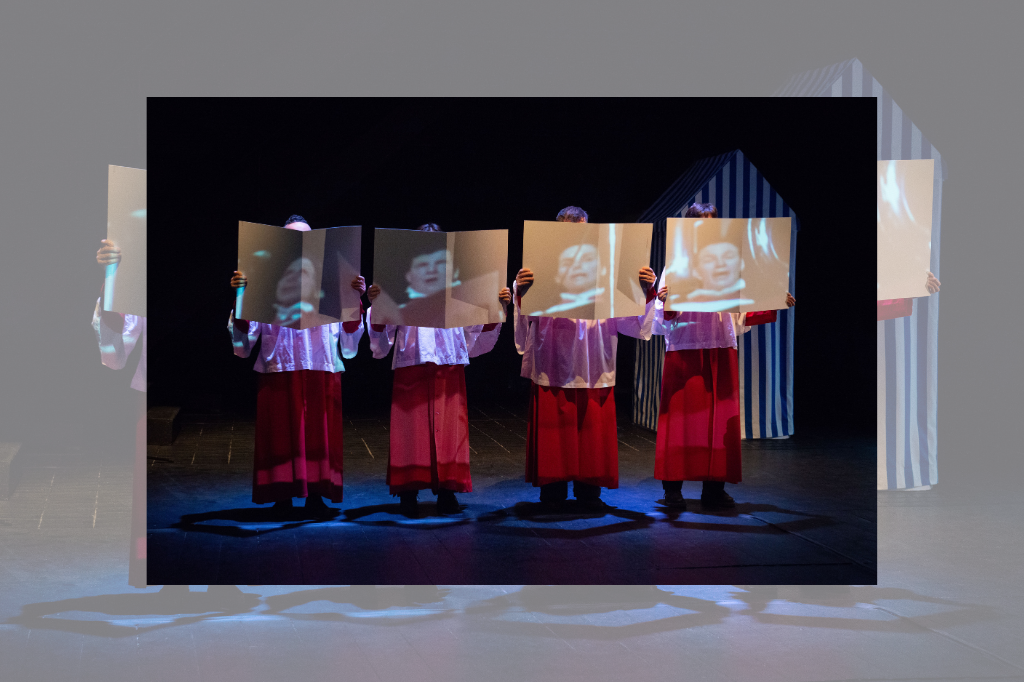REVIEW: Trace at Theatre Passe Muraille/ReDefine Arts
Sharp, personal, and deeply moving, Trace at Theatre Passe Muraille doesn’t quite fit under a single label. It’s a solo show, yes, but it’s a solo show featuring a large choir. It’s stand-up, but it’s stand-up against a backdrop of often unfunny, bittersweet memories. It’s a sound installation, but it’s also a diary; a time capsule; a kaleidoscope of the self through various stages of transition.
In short, Trace isn’t just any one thing. And neither is its creator and performer, Tristan R. Whiston, a trans man whose female-coded childhood lives deeply within him in the form of memories of boychoir (which, though traditionally reserved for pre-pubescent boys, has more recently allowed young children of any age to participate). As Whiston recounts elements of his transition — the day he found the first suit that fit him, the day he chose his new (rhyming) name, the day his father died — he gestures towards videos of his childhood boychoir, which play on large screens behind him. Boychoir plays an enormous role in Trace, right down to the repertoire Whiston and co-creator Moynan King have chosen to include, a timeless arrangement of “The Water Is Wide” and a more retro take on “Come Sail Away” by Styx.
If Trace sounds non-linear, that’s because it is. When the show begins, it’s not too clear what’s in store. Onstage are several ostentatiously placed speakers (with blue, glowing buttons), as well as two large screens and three striped tents, like those you’d see at the beach. When Whiston enters his own tent after walking onstage, a tent kitted out with state-of-the-art sound design equipment (and a brightly logo’d MacBook), abstract images and animations appear on the screens, pulsing rhythmically while a multitude of high-pitched voices say, “can you hear me now?”
Those voices are Whiston’s, we soon learn, recorded at various stages of transition. The recordings are intricate, and often confessional in nature — we hear Whiston document his journey with testosterone, musing about how his voice might change, and what parts of his voice might be lost as he continues on. Through these tape recordings and a healthy dose of retroactive sound editing, Whiston is able to harmonize with himself, and the effect is haunting and quietly brilliant.
There’s a participatory element, too. Those additional tents house tables with tape recorders, and after the show, the audience is invited to experiment with the devices, recording anonymous answers to a series of prompts. Whiston, who does not specify his age but is well into his adulthood, jokes that younger audience members might struggle with the arcane technology — and he was right, at the performance I attended, when a young child from the audience offered to demonstrate but needed help pushing down the buttons all the way.
Trace becomes less personal and more hopeful for the future when, after nearly an hour of boychoir footage and music, we meet a new choir: The Epic Choir of Traceland. Described in online marketing materials as “a newly realized trans/non-binary/gender-queer choir,” the group of young people follow Whiston, singing and taking up space in their changing and changed identities. Their performance of “Come Sail Away” is musically imperfect and choreographically simple: and as such it’s exactly right, a work in progress with just the right amount of heart.
While Whiston controls the narrative of Trace, he’s not alone in bringing it to life. Jeremy Mimnagh’s video designs add lovely visual interest to moments that might otherwise feel static. Trixie and Beever’s set design is just the right amount of nostalgic, though one wonders if there might have been room for just a touch more cohesion between the video design and those striking, striped tents. Jasmine King’s costume design is particularly strong when we meet the Epic Choir of Traceland — the clothes, ranging in texture, colour, and style, nicely play off Whiston’s more muted suit, and the effect is dazzling.
Trace soars because it’s so much more than the sum of its parts, neither solo nor ensemble, neither museum piece nor play. While there might be room for a little more connective tissue between its plethora of ideas — between the boychoir memories and Whiston’s storytelling — Trace is a sentimental, splendid hour of performance.
Trace runs at Theatre Passe Muraille April 21–30, 2023.















Comments